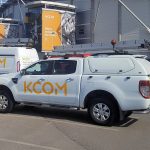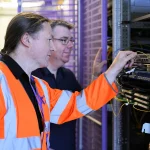UPD Gov Target 1Gbps WiFi and Mobile Broadband on All UK Mainline Trains
The Government’s Department for Digital, Culture, Media and Sport (DCMS) will tomorrow at 9am begin a new ‘Call for Evidence’ on proposals that could help to make WiFi and Mobile (5G) broadband speeds of 1Gbps available onboard all UK mainline train routes by 2025.
At this stage the details are a little vague and we hope to update again once the ‘Call for Evidence’ document has been made available, which will hopefully contain some useful information. Otherwise the press release from DCMS talks about delivering a “dramatic improvement in onboard mobile and Wi-Fi connections” and they claim this could “allow everyone onboard to stream videos simultaneously” (roughly qualified later as “several hundred passengers“).
The proposal goes on to state that fibre optic cables, mobile masts (as well as any necessary power supplies and any onboard kit) could be rolled out alongside tracks to provide Gigabit speeds to trains, although they don’t specifically reference this as being a ‘per passenger‘ expectation and thus it may reflect shared capacity between many users (i.e. everyone could stream video simultaneously but probably not all in 4K, depending upon how many carriages / passengers etc.).
Advertisement
All of this forms part of the Government’s on-going work to foster the next generation of ultrafast 5G mobile networks and links into last week’s announcement of a £35m 5G trial along the Trans Pennine route between Manchester and York etc. (here), as well as £160m from the 2017 Autumn Budget (here). The trial is necessary in order to understand some of the technical and practical deployment challenges of trackside infrastructure.
Matt Hancock MP, UK Minister for Digital, said:
“We want people to be able to get connected where they live, work and travel. This means improving connections on Britain’s railways now, and making sure they are fit for the future. We’ve got a long way to travel but our destination is world-class signal for passengers. This will not only make journeys more enjoyable and productive, but will help improve the operation and safety of the railway and deliver economic benefits for the whole of the UK.”
Chris Grayling, UK Transport Secretary, said:
“We are investing record levels and delivering the biggest rail improvement plan since Victorian times to improve services for passengers – providing faster, better and more comfortable trains with extra seats.
Improved mobile connectivity will help passengers to keep up with work, connect with friends or even check the latest journey information online while on the move, as we continue to build and develop a railway fit for the twenty-first century.”
No doubt rail commuters will relish the prospect of improved on-board connectivity, particularly since mobile service on many train routes can be extremely patchy (partly because most trains still get their mobile signals from remote [non-trackside] masts). Poor reception is obviously a serious drag on a person’s ability to work, shop and / or play while travelling.
At this point it’s worth highlighting that the Government’s Department for Transport has been saying, since 2013 (here), that it plans to make a new generation of “high speed” Mobile Broadband based Internet access services available to 70% of train commuters by 2019 (back in 2013 the talk was of this boosting “customer speeds” up to 50Mbps).
Network Rail already owns trackside fibre along parts of the rail corridor and the announcement adds that, where possible, they will make available access to trackside assets (e.g. fibre, underground ducts, masts and power) on an appropriate basis, to support commercial models. This is an old idea.
Advertisement
NOTE: When politicians say something like “by 2025” they usually mean “by the end of“.
UPDATE 28th Dec 2017
The Call for Evidence DOCUMENT is now available online, although it doesn’t really add much more than is already known. However it is confirmed that the 1Gbps speed is to each train (as expected), rather than each passenger, and it also states that Ofcom will need to “identify the bandwidth [as well as radio spectrum] needed per passenger and per train that passengers ought to expect as a minimum” (as above, previous plans have already indicated 50Mbps per passenger).
We also get some indications of how the Government views potential revenue streams and commercial options.
Advertisement
Potential revenue streams
Under a trackside infrastructure model, the revenue streams may include:* Use of trackside sites to provide improved mobile connectivity to passengers;
* The sale of premium Wi-Fi services to passengers;
* Fees from sale of on-train connectivity to TOCs [Train Operating Companies];
* Fees from use of trackside fibre for wider fixed and mobile backhaul, for example providing fibre to rural communities; and
* Possible sale of capacity to the rail sector for non-safety related communications.
Commercial funding
Options may include:* Providers compete to build trackside solutions and negotiate technical models with railway sector players as needed.
* Running a competition(s) for the establishment of ‘neutral host’ trackside infrastructure models to provide connectivity services to MNOs and/or TOCs. A commercial partner, possibly together with Network Rail, could set up a joint venture to act as an ‘Infra Co’.
* Establishing TOC or MNO led concessions, for example, through obligations in TOC franchise agreements.
It’s worth pointing out that ScotRail in Scotland recently partnered up with Cisco, CGI, Network Rail Telecoms and Wittos (here) to trial “super-fast” WiFi on trains (Project SWIFT), which claims it could offer data speeds of up to 300Mbps (the “fastest in-train Wi-Fi service in the world“). The UK Government has some catching up to do.
We should add that trackside fibre won’t make a huge difference to rural broadband connectivity because the areas passed by trains are often within reach of fibre already. On top of that it’s not so much the core capacity supply that’s the problem, it’s the cost of building such a network out to cover sparse rural communities with very few customers to help repay that investment.
Mark is a professional technology writer, IT consultant and computer engineer from Dorset (England), he also founded ISPreview in 1999 and enjoys analysing the latest telecoms and broadband developments. Find me on X (Twitter), Mastodon, Facebook, BlueSky, Threads.net and Linkedin.
« Netflix UK – 2017 vs 2016 Video Streaming Broadband ISP Speed Index

















































Comments are closed